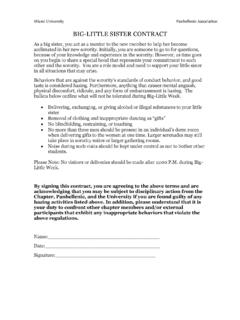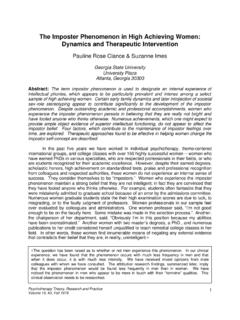Transcription of STUDENT DEVELOPMENT THEORY RESOURCE GUIDE
1 1 STUDENT DEVELOPMENT THEORY RESOURCE GUIDE Application in Fraternity/Sorority Advising 2 INTRODUCTION 3 FOUNDATIONAL THEORIES Chickering & Reisser s THEORY of Identity DEVELOPMENT 4 Sanford Psychosocial DEVELOPMENT Model 7 Schlossberg s THEORY of Marginality and Mattering 9 Myers-Briggs THEORY of Personality Type 11 SOCIAL IDENTITY THEORIES Kohlberg s Moral DEVELOPMENT THEORY 13 Perry s Cognitive DEVELOPMENT THEORY 15 Schaller s Second-Year Experience 17 Renn s Ecological Model of Multiracial Identity DEVELOPMENT 19 Torres Bicultural Orientation Model 21 Cross Model of Psychological Nigrescence 22 D Augelli s Model of Lesbian, Gay, and Bisexual Identity DEVELOPMENT 23 Gilligan s THEORY of women s Moral DEVELOPMENT 25 INTEGRATIVE THEORIES Baxter Magolda s THEORY of Self-Authorship 27 Strange & Banning s Environmental THEORY 30 THE IMPORTANCE OF ASSESSMENT 33 CONCLUSION 34 REFERENCES 35 ACKNOWLEDGEMENTS 38 TABLE OF CONTENTS 3 STUDENT affairs professionals have used STUDENT DEVELOPMENT THEORY to GUIDE their work for almost 40 years (Evans, Forney, & Guido-DiBrito, 1998; Evans, Forney, Guido, Patton, & Renn, 2010; Hamrick, Evans, & Schuh, 2002) and those working with fraternity/sorority life are no exception.
2 Professionals in this field must utilize STUDENT DEVELOPMENT THEORY to help students learn and grow within the context of membership in a fraternal organization. While STUDENT DEVELOPMENT THEORY often places the responsibility for growth on the STUDENT , professionals can and should play a vital role in this process with their students. By effectively using THEORY , one can draw from best practices and add intentionality to their work (Evans, Forney, & Guido-Dibrito, 1998; Evans, Forney, Guido, et al., 2010; Hamrick et al., 2002). McEwen (2003) divided the body of STUDENT DEVELOPMENT THEORY literature into seven families: Cognitive Structural, Psychosocial, Social Identity, Developmental Synthesis, Environmental, Organizational, and STUDENT Success, as well as including a section on theoretical applications and typologies.
3 Within this RESOURCE GUIDE , many of these theories, and their particular relevance in the fraternity/sorority context, are examined. Discussion of these theories has been sectioned into three topical areas: foundational, social, and integrative. Foundational theories are those that provide a general framework for understanding STUDENT DEVELOPMENT , while social theories explore how identities are socially constructed. Finally, integrative theories include those models that focus on identities that are informed by the environmental context of the situation. Suggestions for practical application of these theories within fraternity/sorority life are provided, as well.
4 This RESOURCE is neither exhaustive nor meant to provide an in-depth review of the almost 100 theories (Evans, Forney, Guido, et al., 2010; McEwen, 2003) that can be used to inform STUDENT affairs and fraternity/sorority advising. For a thorough review of theories, readers should consult both editions of STUDENT DEVELOPMENT in College: THEORY , Practice and Research (Evans, Forney, & Guido-DiBrito, 1998; Evans, Forney, Guido, et al., 2010). The reference list located at the end of this document can be used to identify other resources for those who are interested in continued study of STUDENT DEVELOPMENT THEORY . The application of STUDENT DEVELOPMENT THEORY is highly dependent on context, and professionals should be careful not to employ a one-size-fits-all approach (Evans, Forney, Guido, et al.)
5 , 2010; Hamrick et al., 2002). It is important to note that many of the theories discussed within this RESOURCE were developed from research that examined predominately White, traditionally aged students. Keeping this in mind is especially important when working with diverse or non-traditional populations of students. To successfully apply THEORY to practice, fraternity/sorority professionals must keep in mind the specific needs, culture, and diversity of both the individual students and the groups/communities with whom they work. Furthermore, readers should note that particular terminology has been selected to lend consistency to this RESOURCE and is not meant to be exclusive in any manner.
6 While reference is made to fraternity/sorority professionals, we mean for this document to be helpful to any individual that works with the fraternity/sorority community. This includes, but is not limited to, campus-based professionals, inter/national organization staff, alumni, STUDENT affairs practitioners, graduate assistants, and volunteers. INTRODUCTION 4 CHICKERING & REISSER S THEORY OF IDENTITY DEVELOPMENT Chickering, a psychosocial theorist, originally developed an identity DEVELOPMENT THEORY in the early 1960s, eventually publishing the first edition of Education and Identity in 1969 (Chickering, 1969). A few decades later, Chickering partnered with Reisser to expand the THEORY by including additional research on gender, race, and non-traditional students.
7 The result was a second edition of Education and Identity (Chickering & Reisser, 1993) in which the authors identified seven vectors that provide a comprehensive representation of the DEVELOPMENT that occurs during the collegiate years (Evans, Forney, & Guido-DiBrito, 1998). This THEORY is unique in that it does not employ the use of stages or steps to conceptualize growth. Rather, the vectors are described as having direction and magnitude, which are meant to recognize that DEVELOPMENT rarely occurs in a linear progression (Evans, Forney, & Guido-DiBrito, 1998). Movement along the vectors can be sporadic or non-sequential; individuals may even revert backward depending on the situation (Evans, Forney, & Guido-DiBrito, 1998).
8 This freedom allows for individuals to measure their own DEVELOPMENT in a unique and personal way. The seven vectors are developing competence, managing emotions, moving through autonomy toward interdependence, developing mature interpersonal relationships, establishing identity, developing purpose, and developing integrity (Chickering & Reisser, 1993). The first vector, developing competence, consists of three different masteries: intellectual competence, physical and manual skills, and interpersonal competence. Intellectual competence can be described as mastering knowledge as well as developing analytical and critical thinking skills. Physical and manual skills can be developed through creative and artistic outlets in addition to physical and athletic endeavors.
9 Developing interpersonal competence consists of learning how to communicate effectively with others, while discovering appropriate social behaviors needed to successfully build and maintain relationships (Chickering & Reisser, 1993). The second vector, managing emotions, focuses on developing the ability to identify, understand, and exert control over feelings and emotions. Students must strike a balance between positive and negative emotions, as well as learn to act on or release these feelings in a responsible manner. The third vector, moving through autonomy toward interdependence, focuses on the individual moving away from codependence toward independence, eventually gaining an understanding of one s place in relation to the larger community.
10 College often represents the first physical separation a STUDENT experiences away from his/her parents. Living independently presents new challenges and students must learn to problem solve FOUNDATIONAL THEORIES 5 autonomously and self-motivate for the first time. This newfound understanding of personal responsibility helps students to develop or redefine relationships based on mutual giving and interdependence, rather than using others for validation or approval (Chickering & Reisser, 1993). The fourth vector, developing mature interpersonal relationships, builds upon the interconnected community component of the previous vector and consists of two parts: the DEVELOPMENT of an appreciation of differences and the DEVELOPMENT of intimate relationships.






